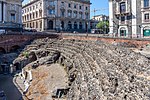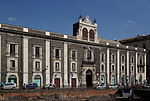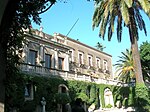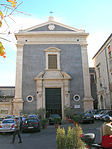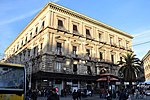Palazzo della Borsa, Catania
Buildings and structures completed in 1930Italian fascist architecturePalaces in Catania

The Palazzo della Borsa is a prominent 20th-century building facing the northwest corner of Piazza Stesicoro, getween Via Sant'Euplio and Via Cappuccini, across the street from Sant'Agata alle Fornace in the city center of Catania, region of Sicily, Italy.
Excerpt from the Wikipedia article Palazzo della Borsa, Catania (License: CC BY-SA 3.0, Authors, Images).Palazzo della Borsa, Catania
Via Cappuccini, Catania Centro storico
Geographical coordinates (GPS) Address External links Nearby Places Show on map
Geographical coordinates (GPS)
| Latitude | Longitude |
|---|---|
| N 37.50758 ° | E 15.08476 ° |
Address
Palazzo della Borsa
Via Cappuccini
95121 Catania, Centro storico
Sicily, Italy
Open on Google Maps
